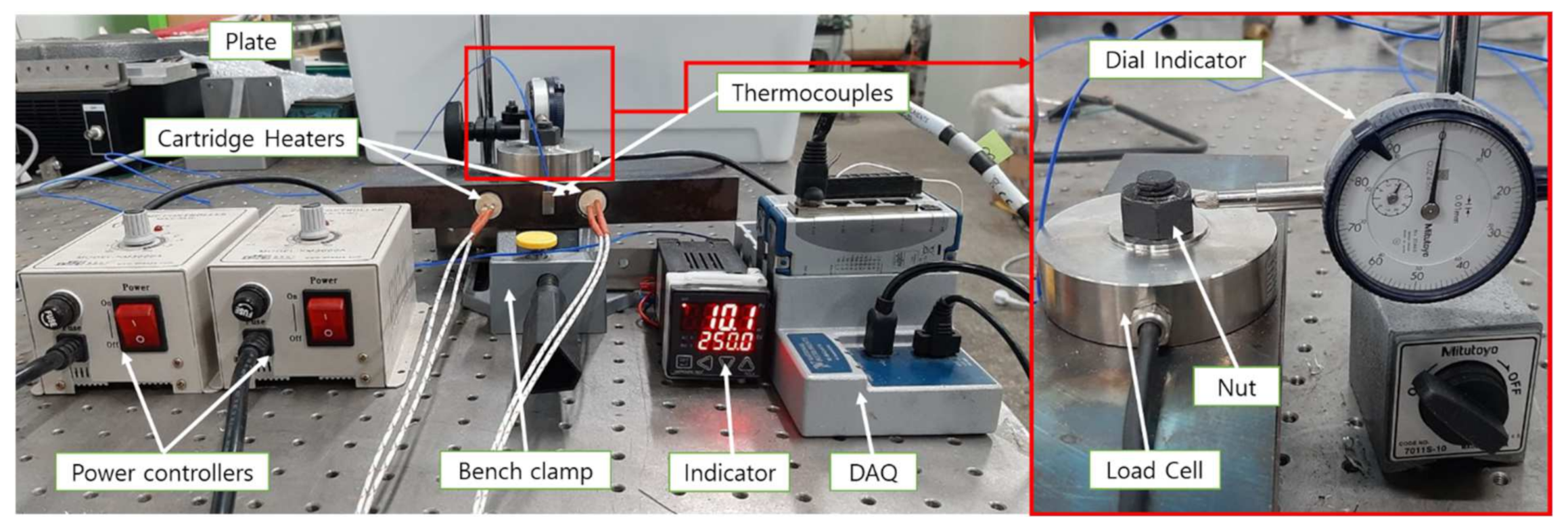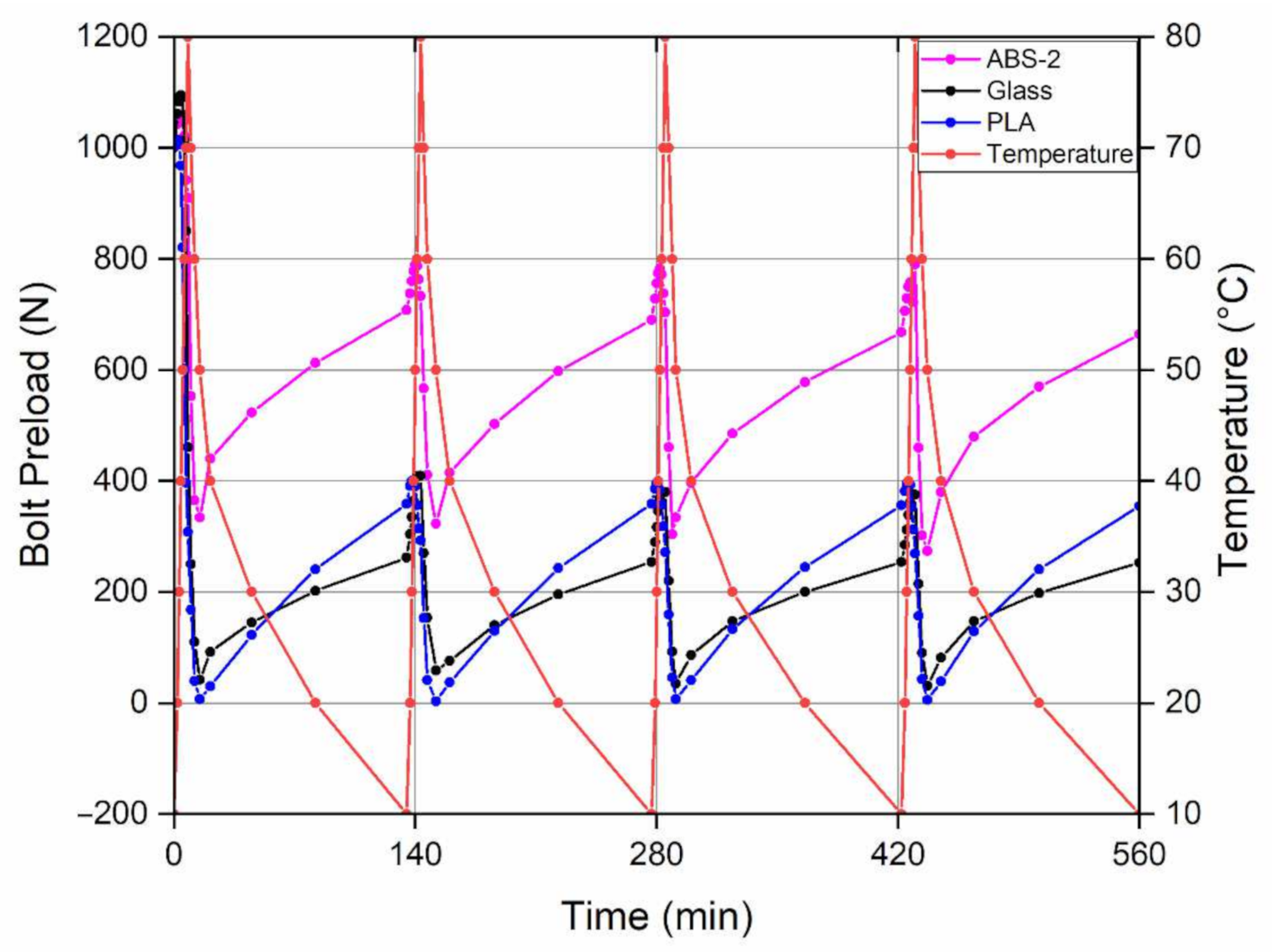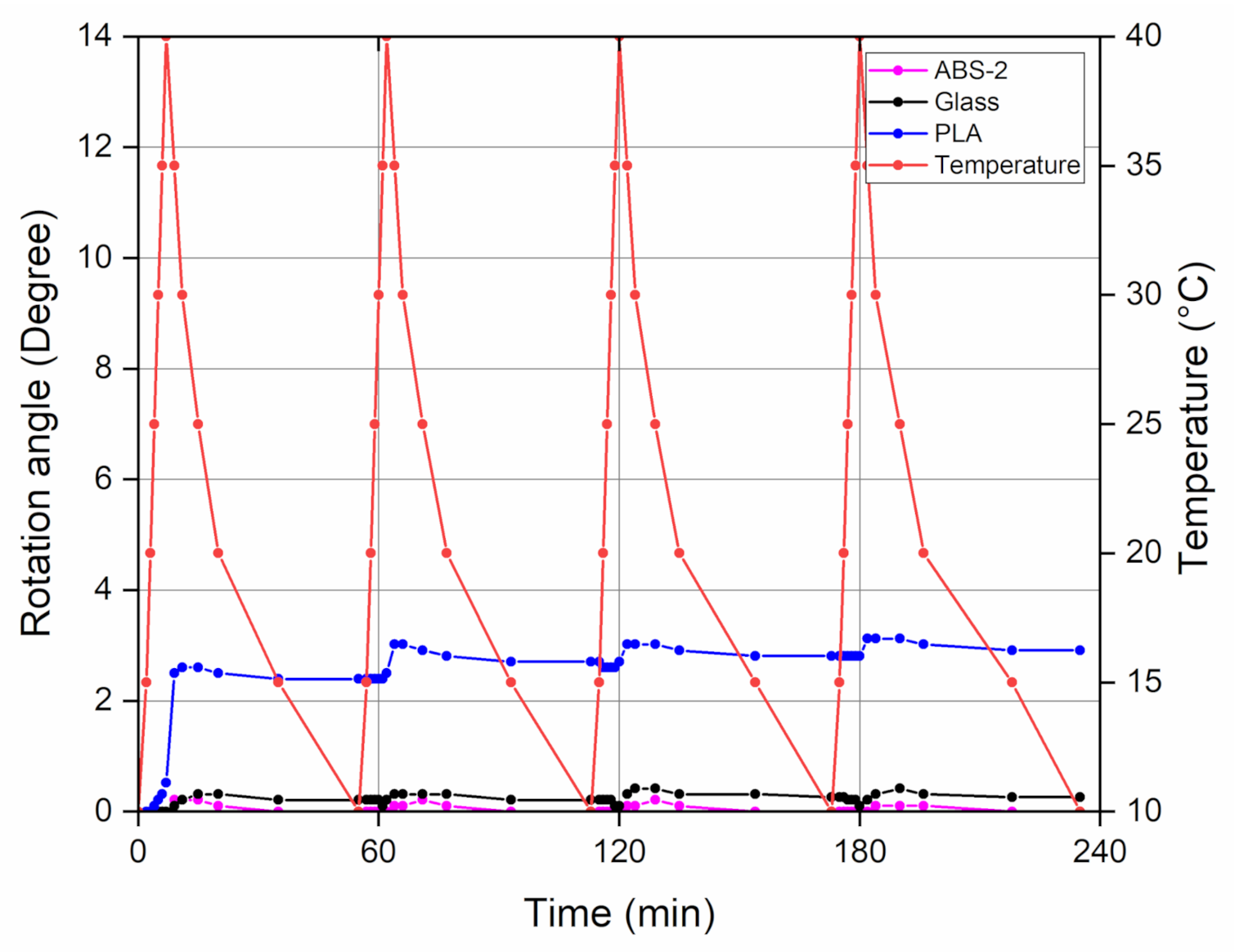Self-Loosening of a 3D-Printed Bolt by Using Three Different Materials under Cyclical Temperature Changes
Abstract
:1. Introduction
2. Materials and Experiment
2.1. Materials
2.2. Bolt Preload
2.3. Test Condition
3. Results and Discussion
3.1. Bolt Preload
3.2. Rotation Angle
4. Conclusions
- Bolt preload for PLA was approximately 1.5 times higher than that of ABS-2 and glass.
- All bolts loosened more in the first cycle of temperature changes than in the rest of the cycles, and the ABS-2 loosened about 2.5 times less in comparison to PLA bolts when temperature changes make up from 10 °C to 40 °C.
- Under high temperature changes, PLA and glass bolts reached the maximum amount of loosening in the first cycle of temperature changes and did not loosen anymore.
- Although the ABS-2 bolt was weaker than the rest of the bolt materials in terms of the maximum preload, it was durable for temperature changes.
Author Contributions
Funding
Institutional Review Board Statement
Informed Consent Statement
Data Availability Statement
Acknowledgments
Conflicts of Interest
References
- Gopinathan, J.; Noh, I. Recent trends in bioinks for 3D printing. Biomater. Res. 2018, 22, 11. [Google Scholar] [CrossRef] [PubMed] [Green Version]
- Yang, W.; Calius, E.; Huang, L.; Singamneni, S. Artificial Evolution and Design for Multi-Material Additive Manufacturing. 3D Print. Addit. Manuf. 2020, 7, 326–337. [Google Scholar] [CrossRef]
- Shafiee, A. Design and Fabrication of Three-Dimensional Printed Scaffolds for Cancer Precision Medicine. Tissue Eng. Part A 2020, 26, 305–317. [Google Scholar] [CrossRef] [PubMed] [Green Version]
- Sears, N.A.; Seshadri, D.R.; Dhavalikar, P.S.; Cosgriff-Hernandez, E. A Review of Three-Dimensional Printing in Tissue Engineering. Tissue Eng. Part B Rev. 2016, 22, 298–310. [Google Scholar] [CrossRef] [PubMed]
- Chand, R.; Sharma, V.S.; Trehan, R.; Gupta, M.K. A physical investigation of dimensional and mechanical characteristics of 3D printed nut and bolt for industrial applications. Rapid Prototyp. J. 2022. [Google Scholar] [CrossRef]
- Feng, X.; Xue, F. Characterization of 3D printed bolts based on digital image correlation and infrared thermography. Mater. Des. 2020, 191, 108641. [Google Scholar] [CrossRef]
- Feng, X. Tentative Experiment on 3D Printed Coal Mine Bolt. In Proceedings of the 5th ISRM Young Scholars’ Symposium on Rock Mechanics and International Symposium on Rock Engineering for Innovative Future, Okinawa, Japan, 1–4 December 2019. [Google Scholar]
- Junker, G.H. New Criteria for Self-Loosening of Fasteners Under Vibration. SAE Tech. Pap. 1969, 78, 314–335. [Google Scholar]
- Yokoyama, T.; Olsson, M.; Izumi, S.; Sakai, S. Investigation into the self-loosening behavior of bolted joint subjected to rotational loading. Eng. Fail. Anal. 2012, 23, 35–43. [Google Scholar] [CrossRef]
- Liu, J.; Ouyang, H.; Feng, Z.; Cai, Z.; Liu, X.; Zhu, M. Study on self-loosening of bolted joints excited by dynamic axial load. Tribol. Int. 2017, 115, 432–451. [Google Scholar] [CrossRef]
- Sawa, T.; Ishimura, M.; Shoji, Y.; Fukuba, Y. Mechanical behavior of rotational screw thread loosening in bolted joints under repeated temperature changes. In Proceedings of the American Society of Mechanical Engineers, Pressure Vessels and Piping Division (Publication) PVP, American Society of Mechanical Engineers Digital Collection, Chicago, IL, USA, 27–31 July 2008; Volume 2, pp. 245–252. [Google Scholar]
- Eraliev, O.M.U.; Zhang, Y.H.; Lee, K.H.; Lee, C.H. Experimental investigation on self-loosening of a bolted joint under cyclical temperature changes. Adv. Mech. Eng. 2021, 13, 1–8. [Google Scholar] [CrossRef]
- Hou, S.; Liao, R.; Li, J. A Mathematical Model for Temperature Induced Loosening due to Radial Expansion of Rectangle Thread Bolted Joints. Adv. Mech. Eng. 2015, 7, 7. [Google Scholar] [CrossRef]
- Anderson, I. Mechanical Properties of Specimens 3D Printed with Virgin and Recycled Polylactic Acid. 3D Print. Addit. Manuf. 2017, 4, 110–115. [Google Scholar] [CrossRef]
- Kumar, R.; Singh, R.; Farina, I. On the 3D printing of recycled ABS, PLA and HIPS thermoplastics for structural applications. PSU Res. Rev. 2018, 2, 115–137. [Google Scholar] [CrossRef]
- Zadoks, R.I.; Yu, X. An Investigation of the Self-Loosening Behavior of Bolts Under Transverse Vibration. J. Sound Vib. 1997, 208, 189–209. [Google Scholar] [CrossRef]
- Eraliev, O.; Lee, K.; Lee, C. Vibration-Based Loosening Detection of a Multi-Bolt Structure Using Machine Learning Algorithms. Sensors 2022, 22, 1210. [Google Scholar] [CrossRef]
- Takemasu, T.; Shinbutsu, T.; Amano, S.; Shimura, J. Development of Anti-Loosening Bolts Based on Innovative Double Thread Mechanism. Miner. Met. Mater. Ser. 2021, 2155–2165. [Google Scholar]
- Zhou, W.; Zhang, R.; Ai, S.; He, R.; Pei, Y.; Fang, D. Load distribution in threads of porous metal-ceramic functionally graded composite joints subjected to thermomechanical loading. Compos. Struct. 2015, 134, 680–688. [Google Scholar] [CrossRef] [Green Version]
- Zhou, W.; Zhang, R.; Fang, D. Design and analysis of the porous ZrO2/(ZrO2+Ni) ceramic joint with load bearing-heat insulation integration. Ceram. Int. 2016, 42, 1416–1424. [Google Scholar] [CrossRef] [Green Version]
- Harshitha, V.; Rao, S.S. Design and analysis of ISO standard bolt and nut in FDM 3D printer using PLA and ABS materials. Mater. Today Proc. 2019, 19, 583–588. [Google Scholar] [CrossRef]
- Wi, J.-H.; Ahn, H.-J.; Lee, K.-H.; Lee, C.-H. Self-Loosening Characteristics of Three-Dimensional Printed Bolted Joints. 3D Print. Addit. Manuf. 2019, 6, 354–360. [Google Scholar] [CrossRef]
- Alexandre, A.; Cruz Sanchez, F.A.; Boudaoud, H.; Camargo, M.; Pearce, J.M. Mechanical Properties of Direct Waste Printing of Polylactic Acid with Universal Pellets Extruder: Comparison to Fused Filament Fabrication on Open-Source Desktop Three-Dimensional Printers. 3D Print. Addit. Manuf. 2020, 7, 237–247. [Google Scholar] [CrossRef]
- Alfredo Campo, E. Selection of Polymeric Materials; Elsevier: Amsterdam, The Netherlands, 2008. [Google Scholar]
- Shrivastava, A. Introduction to Plastics Engineering; Elsevier: Amsterdam, The Netherlands, 2018; 262p. [Google Scholar]








| Mechanical Properties | PLA | ABS-2 | GLASS |
|---|---|---|---|
| Tensile strength | 47.95 MPa | 45 MPa | 39.57 MPa |
| Elongation at max tensile stress | 3.80% | 2.5% | 5.94% |
| Glass transition temperature | 57.06 °C | 97 °C | 78.06 °C |
| Specific density | 1.292 g/cm3 | 1.05 g/cm3 | 1.409 g/cm3 |
| Melting point | 150 to 160 °C | 267 °C | 225 °C |
Publisher’s Note: MDPI stays neutral with regard to jurisdictional claims in published maps and institutional affiliations. |
© 2022 by the authors. Licensee MDPI, Basel, Switzerland. This article is an open access article distributed under the terms and conditions of the Creative Commons Attribution (CC BY) license (https://creativecommons.org/licenses/by/4.0/).
Share and Cite
Eraliev, O.; Lee, K.-H.; Lee, C.-H. Self-Loosening of a 3D-Printed Bolt by Using Three Different Materials under Cyclical Temperature Changes. Appl. Sci. 2022, 12, 3001. https://doi.org/10.3390/app12063001
Eraliev O, Lee K-H, Lee C-H. Self-Loosening of a 3D-Printed Bolt by Using Three Different Materials under Cyclical Temperature Changes. Applied Sciences. 2022; 12(6):3001. https://doi.org/10.3390/app12063001
Chicago/Turabian StyleEraliev, Oybek, Kwang-Hee Lee, and Chul-Hee Lee. 2022. "Self-Loosening of a 3D-Printed Bolt by Using Three Different Materials under Cyclical Temperature Changes" Applied Sciences 12, no. 6: 3001. https://doi.org/10.3390/app12063001
APA StyleEraliev, O., Lee, K.-H., & Lee, C.-H. (2022). Self-Loosening of a 3D-Printed Bolt by Using Three Different Materials under Cyclical Temperature Changes. Applied Sciences, 12(6), 3001. https://doi.org/10.3390/app12063001







